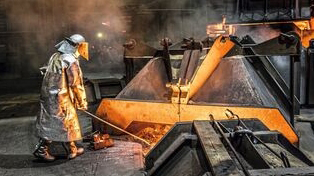
Calcium treatment is an effective way to modify oxide inclusions into low melting temperature inclusions that do not cause clogging problems. [21]
Figure 1.7 shows the number density of the MnS stripes and globular sulfides in the 49MnVS3 steel before and after calcium treatment. The sulfide content of the oxide core also decreases with increasing Ca addition amount in LF refining process.
The calcium treatment process can control the composition, morphology and distribution of inclusions in aluminum-killed steel. One of the most common applications is to avoid nozzle clogging during continuous casting by transforming solid alumina inclusions into liquid ones [1].
In addition, it can modify oxide and sulfide inclusions to promote their segregation from the iron crystals. When the sulfide inclusions are modified, they can precipitate as (Mn, Ca)S and wrap the stoichiometric components of the molten steel, resulting in a reduction in the size of cellular ferrite grains.
X-ray diffraction analysis showed that the alumina inclusions in the samples after Ca treatment became less crystalline and more dispersed. In the case of sulfide inclusions, it was found that they could also change their shape and morphology to improve deformation behavior. The mnS inclusions without an oxide core were more likely to become long strips, while the MnS including an oxide core had a higher probability of becoming a hexagonal shape.
The kinetics of microstructure transformation is determined by the thermodynamic parameters. For example, a change in the temperature gradient within the melt pool generates an increase in the thermal energy available for dislocation movement. This increases tensile strength, yield strength and elongation.
The composition of oxide inclusions may evolve during the steel solidification process by reaction with elements that remain dissolved in the liquid iron or with other precipitated phases such as sulfides. Targeting the oxide inclusion composition to a low melting point is an important aspect of inclusion control.
Adding Ca to the steel melt modifies the composition and morphology of oxide inclusions by converting them to a liquid calcium aluminate, which prevents nozzle clogging during continuous casting. In the current experiment, more than 100 inclusions were counted and analyzed with EDS. The results showed that the proportion of complex inclusions with an oxide core decreased. Single-phase MnS inclusions, which tended to deform into long strips, also reduced.

As a calcium deoxidizer and desulphurizer, calcium treatment can change the shape of hard inclusions such as Al2O3 and MnS. These changes affect the deformation behaviour of the inclusions. This behaviour has a direct influence on the toughness of the steel.
The morphology and orientation of inclusions also plays an important role in fracture modes. The cleavage fracture mode, for example, is most affected by the presence of manganese sulphide inclusions. These inclusions, which are often elliptical in shape, create micro voids in the grain boundaries, which affect ductility.
In addition, hard inclusions can also cause segregation and abrasion. In the case of alumina inclusions, they can redistribute and break due to their low bonding strength with the matrix. This causes a loss of toughness, so it is important to understand how the size and morphology of these inclusions can be controlled. For this, several studies have been conducted on the reaction between alumina and calcium.
The calcium is normally added in a stabilized form, such as calcium silicon, delivered by cored wire using a wire injection system. It is injected into the molten steel deep inside, and is dissolved in and reacts with inclusions, oxygen and sulfur. It is also a powerful deoxidizer and desulphurizer, which leads to the reduction in the number of inclusions and modifications in their shape.
The scanning pictures of the inclusions before and after calcium treatment showed that the MnS and oxide inclusions were modified into liquid Ca-aluminate inclusions. The (Ti,V)(C,N) inclusions did not change their morphology significantly.
The amount of the Mg and Al in the oxide cores was counted after the calcium treatment, and the results were similar to those of the 16MnCrS5 and 49MnVS3 steels. Adding 7 ppm of Mg was enough to make the MnS and CaO-Al2O3 inclusions disappear and form spinel phase MgO*Al2O3. In addition, the MnS with an oxide core was changed into a single MnS.

Write a Message